|
|
|
| The
wormfishes are tiny and rarely seen
fishes found near reefs. There are only
two Caribbean wormfish genera: Cerdale
floridana and the genus Microdesmus
with five regional species.
Fortunately, fin-ray counts clearly
distinguish the regional species, which
share almost all other larval characters
and markings. Despite the small size
of the adults, the larvae are usually
large and not uncommon in larval collections. |
|
| The
dartfishes, previously in the family
Ptereleotridae, have been taxonomically
mobile in recent years and taxonomists
now include them in the wormfish family
Microdesmidae. Larval
ptereleotrids most closely resemble
the "long" larvae of my Group
4 gobies. There are only two dartfish
species in the region, a pair of sibling
species that vary only slightly in color:
their larvae are likely identical. |
| |
| Larval
microdesmids are long and worm-like
with a prominent mid-body swim bladder.
They have a characteristically blunt,
hooked, and protruding lower jaw and
more, usually many more, than 35 elements
in the dorsal fin and 23 in the anal
fin. These features easily distinguish
them from the gobies
and other gobioids.
Wormfish larvae are morphologically
similar to the larval pikeblennies of
Chaenopsis,
but the latter have long and thread-like
pelvic fins while larval wormfishes
have inconspicuous pelvic fins. Transforming
eel larvae of many families may superficially
resemble larval microdesmids, but the
eels do not have a normal caudal fin
as do both the microdesmids and chaenopsids. |
|
|
|
|
|
|
|
|
|
| Diagnosis:
Modal fin-ray counts of D-VI,23 A-22
Pect-21 indicate Ptereleotris
helenae (Hovering Goby or Hovering
Dartfish) or P.
calliurus (Blue Dartfish). The dartfishes
have been moved around taxonomically recently
and presently reside in Microdesmidae with
the wormfishes, although they appear more
similar to gobioids in general appearance,
and as larvae, especially having a separate
first spinous dorsal fin. The fin-ray counts
are unique to this genus in the region, where
no other gobioid exceeds 22 second-dorsal-fin
elements (some Microgobius
signatus individuals can occasionally
reach 22 elements and larval Palatogobius
have up to 21: these gobies have seven first-dorsal-fin
spines and do not have the obviously separate
pelvic fins of Ptereleotris),
and no other microdesmid species have separated
dorsal fins and with so few elements. There
are two regional species: P. helenae
throughout most of the Caribbean and the sibling
species P. calliurus from Florida and
the Gulf of Mexico. (U) g21 |
|
| Analogues:
Larval Ptereleotris
helenae have unique markings compared
to the gobioids, especially a long row of
melanophores along the base of the dorsal
fins in a pre-transitional larva. Their body
form is similar to larval Microgobius,
but the melanophore patterns are quite different.
The markings of larval Ptereleotris
helenae are similar to those found
in some larval labrisomids
or chaenopsids,
but larvae of those families do not have the
distinctive separate and short spinous dorsal
fin. |
|
| Description:
Body thin, long and narrow with a
large eye and a large terminal mouth. Pectoral
fins short, pelvic fins medium-length, extending
less than halfway to the vent, clearly separate
with no frenum. Dorsal and anal-fin bases
very long, caudal peduncle very short and
narrow, procurrent caudal-fin rays 7-9 (7-8
spindly). Lightly marked along the dorsal
and ventral midlines: melanophores in rows
on the body near the base of the spinous dorsal
fin, variably paired and offset from the midline,
then in rows near the base of the second dorsal
fin, one offset pair per fin element, then
extending onto the dorsal midline at the caudal
peduncle ending at the start of the procurrent
caudal-fin rays. Melanophores are present
on some of the central and lower segmented
caudal-fin rays. There is a row of melanophores
along the anal-fin base (variably paired,
one per side, a few larger ones starting at
the fifth or sixth element that are fewer
than one per ray, then becoming small and
usually one per ray around the tenth element),
and then a streak along the ventral midline
of the very short caudal peduncle ending at
the start of the procurrent caudal-fin rays.
There are no melanophores at the isthmus or
at the pelvic-fin insertion. On the head there
is a pair of large melanophores at the rear
of the braincase on each side of the dorsal
midline. Internal melanophores are present
around the sacculus, along the dorsal surface
of the swim bladder and around the gut near
the vent. The eye is large and round. |
|
|
|
| Ptereleotris
helenae larva |
| 12.2 mm SL |
| note separated
pelvic fins |
| San Blas, Panama,
SB82-016 |
|
 |
| |
 |
| |
 |
| |
 |
| |
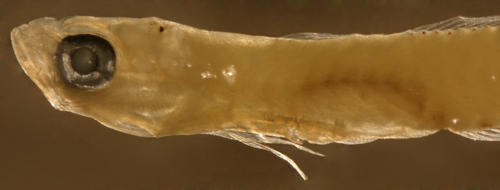 |
|
|
|
|
| |
|
|
|
| Diagnosis:
The modal fin-ray count of D-XIII,31-32
(XII-XIV,30-34) A-30-31 (28-33) indicates
Cerdale floridana.
(U) md2 |
|
|
Analogues: |
|
| Description:
Body somewhat thick, very long and
narrow with a small head and round medium-sized
eye and mouth with a blunt, hooked, and protruding
lower jaw. Pectoral fins short and pelvic
fins separate and short. Dorsal and anal fin
bases very long, caudal peduncle very short
and relatively wide. The caudal fin has a
distinct vertical row and three lateral rows
of caudal fin neuromasts (sensory papillae)
and there are 5-7 procurrent caudal fin rays
(5-6 spindly). Very lightly marked, mostly
along the ventral midline: a melanophore at
the pelvic fin base (often missing), followed
by a pair of short rows of melanophores diverging
from the pelvic fin base along the side of
the abdominal gut strip. There is a row of
melanophores along the base of the anal fin
rays after the first three (paired and one
per ray), becoming more disassociated from
the anal fin base and more variable in number
and depth at the last several rays and continuing
into the ventral caudal peduncle ending at
the start of the lower procurrent caudal fin
rays. A few scattered melanophores sometimes
extend out along the lower segmented caudal
fin rays. A rare individual has a surface
melanophore on the lateral aspect of the caudal
peduncle (a characteristic of larval Microdesmus
spp.), although it is off-center from
the lateral midline. Dorsal markings consist
of a few off-center and variably-paired melanophores
at the base of some posterior dorsal fin rays
continuing onto the dorsal caudal peduncle
ending at the start of the upper procurrent
caudal fin rays. Some larvae have a melanophore
at the angle of the jaw. Internal melanophores
occur around the saccule and along the dorsal
surface of the swim bladder (not at the vent).
|
| |
|
|
 |
| Cerdale
floridana larva |
| 18.9 mm SL |
| San Blas, Panama,
SB86-1001 |
|
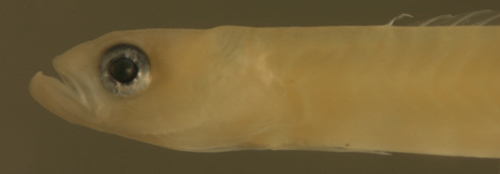 |
| |
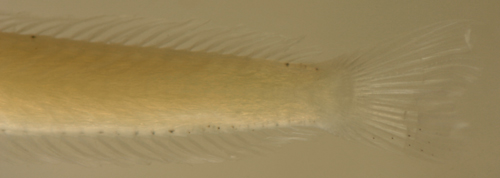 |
| |
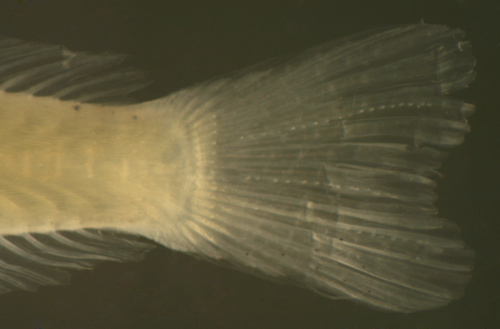 |
| |
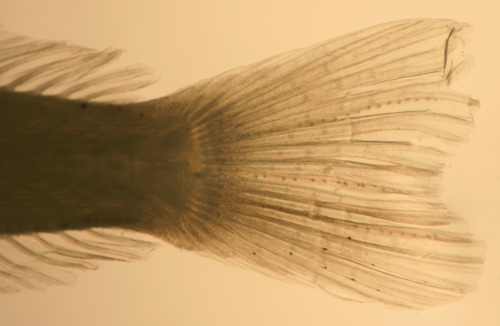 |
| Cerdale
floridana larva |
| 19.0 mm SL |
| head neuromasts
|
| San Blas, Panama,
SB86-1001 |
|
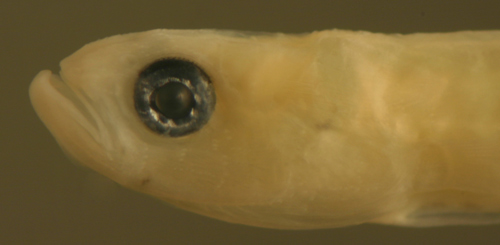 |
| Cerdale
floridana larvae |
| 19.0 and 18.9
mm SL |
| dorsal view of
caudal peduncle (below) |
| San Blas, Panama,
SB86-1001 |
|
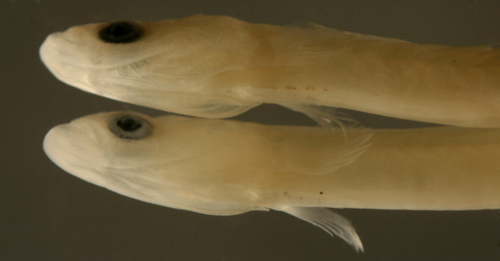 |
| |
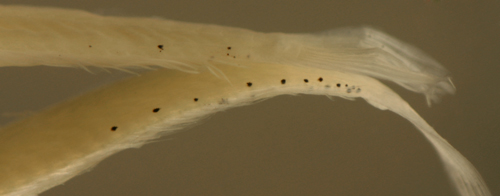 |
| Cerdale
floridana larva |
| 19.4 mm SL |
| lateral caudal
peduncle melanophore |
| San Blas, Panama,
SB87-101 |
|
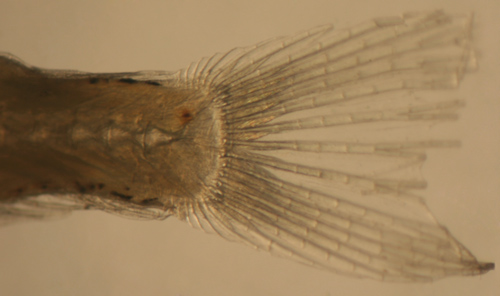 |
|
|
|
|
|
|
|
| Diagnosis:
The fin-ray count range of D-IX-XII,26-30
A-24-28 indicates Microdesmus
bahianus. (U) |
|
| Analogues:
|
|
| Description:
Body somewhat thick, very long
and narrow with a small head and round
medium eye and mouth with a hook-like
protruding lower jaw with a bulbous
tip. |
|
|
|
|
|
|
|
|
|
| Diagnosis:
The fin-ray count range of D-XXV-XXVII,43-45
A-36-37 indicates Microdesmus
carri. This is the only Caribbean microdesmid
with more than 23 dorsal fin spines. (U) |
|
| Analogues:
|
|
| Description:
Body somewhat thick, very long and
narrow with a small head and small to medium-sized
round eye and a large mouth with a hook-like
protruding lower jaw with a bulbous tip. Pectoral
fins short and pelvic fins separate and short.
Dorsal and anal fin bases very long, caudal
peduncle very short and relatively wide, 5-6
procurrent caudal fin rays (5 spindly). Lightly
marked, mostly along the ventral midline:
melanophores at the isthmus, a short row of
about four just forward of the pelvic fin
base continuing as a short row behind the
pelvic fin base then diverging into a pair
of rows along the sides of the abdominal gut
strip. There is a row of melanophores along
the base of all of the anal fin rays (paired
and one per ray) continuing as a short row
of about three melanophores along the ventral
caudal peduncle midline ending before the
procurrent caudal fin rays. There are melanophores
along the base of some of the last dorsal
fin rays (paired, off-center, and one per
ray) continuing along the dorsal caudal peduncle
midline ending before the procurrent caudal
fin rays. There is a short row of about three
melanophores along the lateral midline of
the caudal peduncle. Melanophores line the
proximal third of the lower central caudal
fin rays and the mid- and distal portion of
the several lowest segmented caudal fin rays.
Melanophores on the head are limited to a
pair at the angles of the jaw. Internal melanophores
occur around the saccule and along the dorsal
surface of the swim bladder (not at the vent).
|
|
|
|
| Microdesmus
carri larva |
| 30.3 mm SL |
| San Blas, Panama,
SB86-1103 |
|
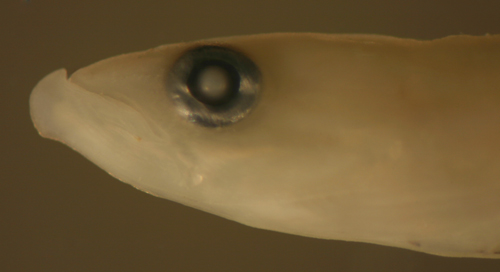 |
| |
 |
| |
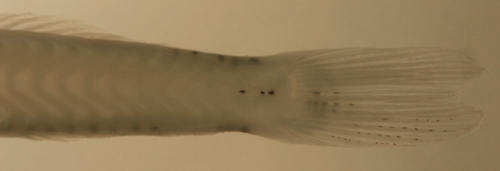 |
| Microdesmus
carri larva |
| 30.4 mm SL |
| San Blas, Panama,
SB86-701 |
|
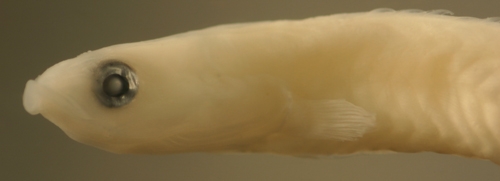 |
|
|
|
|
|
|
|
|
| Diagnosis:
The fin-ray count range of D-XI-XIII,51-61
A-48-56 indicates Microdesmus
lanceolatus .(U) |
|
| Analogues:
Content goes here |
|
| Description:
Body somewhat thick, long and narrow
with a small head and round eye, small mouth
and hook-like protruding lower jaw with a
bulbous tip. |
|
|
|
|
|
|
|
|
| Diagnosis:
The fin-ray count range of D-XIX-XXIII,
51-52 (40-58) A-44 (36-52) indicates Microdesmus
longipinnis. (U) |
|
| Analogues:
|
|
| Description:
Body somewhat thick, long and narrow
with a small head and round eye, small mouth
and hook-like protruding lower jaw with a
bulbous tip. |
|
|
|
|
|
|
|
|
| Diagnosis:
The fin-ray count range of D-XII-XIII,37-38
A-35 indicates Microdesmus
luscus. md5(U) |
|
| Analogues:
|
|
| Description:
Body somewhat thick, very long and
narrow with a small head and small round eye
and medium-sized mouth with only a slightly
protruding lower jaw. Pectoral fins short
and pelvic fins separate and short. Dorsal
and anal fin bases very long, caudal peduncle
very short and relatively wide, 5-6 procurrent
caudal fin rays (5 spindly). Lightly marked,
mostly along the ventral midline: melanophores
at the isthmus, just forward of the pelvic
fin base and just behind the pelvic fin base
diverging into a pair of short rows along
the side of the abdominal gut strip. There
is a row of melanophores along the base of
all of the anal fin rays (paired and one per
ray), becoming more disassociated from the
anal fin base and more variable in number
and depth at the last several rays and continuing
along the ventral caudal peduncle midline
ending under the first lower procurrent caudal
fin ray. There are melanophores along the
base of the last two dorsal fin rays (paired,
off-center, and one per ray), and continuing
along the dorsal caudal peduncle midline ending
under the first upper procurrent caudal fin
ray. There are one or two discrete large melanophores
along the lateral midline of the caudal peduncle.
Melanophores line the proximal third of the
lower central caudal fin rays and the full
length of the several lowest segmented caudal
fin rays. Melanophores on the head are limited
to a pair at the angles of the jaw. Internal
melanophores occur around the saccule and
along the dorsal surface of the swim bladder
(not at the vent). |
|
|
|
| Microdesmus
luscus larva |
| 22.3 mm SL |
| San Blas, Panama,
SB87-101 |
|
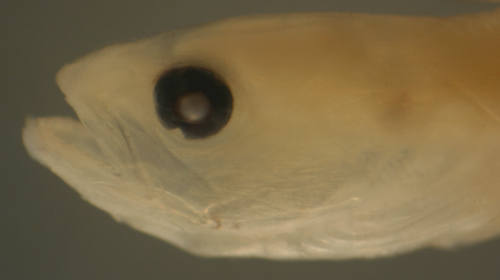 |
| |
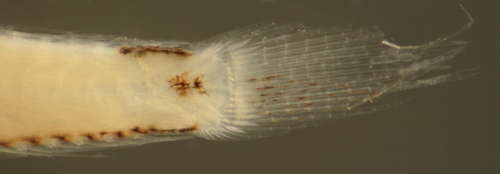 |
 |
|
|
|
|
|
|
 |
|
All contents copyright
2006-2018
All rights reserved
www.coralreeffish.com
by Benjamin Victor
|
|
|
|
| |
|